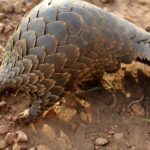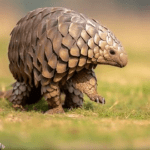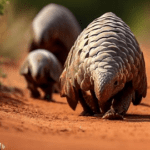Pangolins, aka ‘scaly anteaters‘, inhabit parts of Asia and Africa. They have a unique physical form, with thick keratin scales protecting them. When threatened, they curl up into a ball – using their strong front legs and armor-like scales. Plus, their sense of smell helps them find prey underground or in termite mounds.
Sadly, their populations are critically endangered on the IUCN Red List. Despite being protected, pangolins continue to be victims of illegal wildlife trade.
For centuries, pangolin meat and scales have been delicacies in traditional Chinese medicine. But, due to the high demand for illegal wildlife products, pangolin populations are rapidly declining. Organizations like WWF are working hard to raise awareness and combat the illegal trade that threatens their survival.
Key Takeaways
- Pangolins are the most trafficked mammals in the world, primarily due to the demand for their scales and meat in traditional Chinese medicine.
- Pangolins are critically endangered, with all eight species facing the risk of extinction.
- The illegal trade of pangolins has increased significantly in recent years, driven by organized criminal networks.
- Efforts to combat the illegal trade of pangolins have been challenging due to limited resources and corruption.
- Public awareness and education about the importance of pangolins in ecosystems and the need for their conservation are crucial in protecting these species.
- International cooperation and stricter law enforcement are necessary to curb illegal trade and protect pangolins.
- Sustainable alternatives to traditional Chinese medicine, such as herbal remedies, should be promoted to reduce the demand for pangolin products.
- Conservation organizations and governments need to work together to strengthen legislation and penalties for pangolin trafficking.
- Protecting pangolins also indirectly benefits other wildlife and ecosystems, as they play a vital role in controlling insect populations.
- Supporting local communities in pangolin conservation efforts can provide alternative livelihoods and reduce the incentive for illegal trade.
Overview of Pangolins

Pangolins? Scaly anteaters? Fascinating mammals? Yes, yes, and yes! Native to Asia and Africa, these unique creatures have earned the attention of conservationists and wildlife enthusiasts around the world. Why? Their distinctive physical characteristics and their unfortunate status as the most trafficked mammal on Earth.
Pangolins are easily recognizable – they’re covered in scales to protect themselves from predators! There are 8 species, each with its own physical attributes and habitat preferences. From the white-bellied pangolin found in Central Africa to the Chinese pangolin in China and Vietnam, they vary in size, shape, and color.
Unfortunately, all 8 pangolin species are listed as critically endangered on the IUCN Red List. This is due to poaching and illegal trade driven by the demand for their meat and scales, which are believed to have medicinal properties. As a result, pangolins are protected by national and international laws, such as CITES.
Organizations like WWF are working hard to combat wildlife crime, support local communities, and advocate legislation to protect pangolins‘ natural habitats. Recently, a team of dedicated researchers discovered a previously unknown population of Sunda pangolins living deep within a forest reserve in Malaysia.
These endearing creatures deserve our admiration and protection. By working together, we can ensure a brighter future for pangolins and the countless other species that rely on the balance of our natural world. Move aside, Kardashians. These pangolins are the real stars of the animal kingdom!
Species of Pangolins
Pangolins are mammals with unique features, such as their scales and strong front legs. Plus, they’re often called “anteaters” due to their diets of ants and termites. There are 8 species of pangolins found around the world, each with their own characteristics and habitats.
Let’s learn about these 8 species:
- Chinese Pangolin – Found in China & Vietnam. Critically endangered, with scales making up 20% of its body weight.
- Sunda Pangolin – Southeast Asia. Critically endangered and one of the most trafficked mammals.
- Indian Pangolin – Indian subcontinent. Protected under national & international laws due to illegal trade in meat & scales.
- Philippine Pangolin – Philippines. Listed as critically endangered on the IUCN Red List of Threatened Species.
- White-bellied Pangolin – Sub-Saharan Africa. Threatened species due to habitat loss & poaching of its meat.
- Black-bellied Pangolin – Central Africa. Also threatened by habitat loss & illegal trade.
- Giant Pangolin – West & Central Africa. Largest species, reaching 5 feet. Critically endangered on the IUCN list.
- Temminck’s Ground Pangolin – Sub-Saharan Africa. Has large overlapping scales for protection.
Pangolins play essential roles in ecosystems but face threats from humans. We can help protect them by:
- Raising awareness of their plight.
- Supporting conservation organizations.
- Advocating stronger laws.
- Choosing sustainable alternatives.
- Engaging local communities.
Let’s make a world where pangolins thrive in their natural habitats without human interference!
Pangolin Scales and Traditional Chinese Medicine
Pangolin scales have long been used in Traditional Chinese Medicine (TCM) due to their perceived medicinal properties. These scales are thought to help with many issues, such as improving blood circulation, treating skin conditions, and relieving inflammation. In TCM, they are usually powdered or made into tea.
Table of Uses in TCM:

- Treatment of blood circulation issues
- Healing of skin conditions
- Relief from inflammation
- Promoting general health and wellness
However, limited scientific evidence supports the effectiveness of pangolin scales. This demand for them has caused illegal trade and poaching, putting these species at risk.
To protect pangolins and stop this illegal trade, we need to raise awareness and spread the word. We can support organizations like WWF that work to conserve wildlife and be part of the movement to save pangolins from extinction!
The Illegal Trade of Pangolins
The illicit trade of pangolins is a grave concern for wildlife conservationists worldwide. These creatures are known for their unique physical characteristics and scales and are the most trafficked mammals on the planet. Despite legal protection, they are still hunted and traded illegally.
The demand for pangolins stems from their scales and meat, being used in traditional Chinese medicine and as a delicacy. Unfortunately, this belief has fueled illegal trading, and their population is at risk.
The trafficking of pangolins has caused a devastating decrease in their habitats and numbers. There are eight species of pangolins protected, four in Asia and four in Africa, yet poaching continues to occur due to the high demand for their products.
To tackle this issue, many solutions should be implemented. Raising awareness about their endangered status is crucial. Educating local communities, consumers, and potential buyers can help reduce the demand for illegal products.
Law enforcement efforts need to be strengthened to combat this crime effectively. Governments should allocate resources to enforce regulations and prosecute those involved in illegal trade. Cooperation between countries is also vital to tackle cross-border smuggling networks.
Supporting local communities near pangolin habitats is essential. Creating alternative livelihoods such as ecotourism or sustainable agriculture can provide economic incentives to protect these extraordinary creatures.
Pangolins in the News

Pangolins are the most trafficked mammals in the world. Recently, they have been making headlines due to their critically endangered status. These animals look like a mix of an armadillo and an anteater, with a scaly exterior. They are found in Asia and Africa and play an important role in controlling termite and ant populations.
The illegal trade of these creatures is due to the demand for their scales and meat. The scales are used in traditional Chinese medicine and the meat is a delicacy. All eight species of pangolins are protected by national and international laws, including CITES. But, they still face threats due to poaching and habitat loss.
Organizations like the WWF are trying to help pangolins. They are researching and protecting their habitats, as well as creating public awareness campaigns to educate people. An example of the illegal trade of pangolins is the interception of a shipment of 4 tons of pangolin scales destined for Vietnam. This emphasizes the need for immediate action to protect these animals.
The Role of WWF in Pangolin Conservation
WWF is a major player in pangolin conservation. They raise awareness and combat illegal trade. WWF also supports research, works with local communities, and promotes sustainable livelihoods. They also strengthen anti-poaching measures and support policy development.
Plus, they collaborate across borders to tackle the global illegal wildlife trade. A great example is Nouabale-Ndoki National Park in Central Africa. WWF works with the community to protect pangolin habitats. This has led to a decrease in poaching incidents.
WWF is dedicated to protecting pangolins and ensuring a future where both humans and wildlife can live harmoniously. Pangolins may be endangered, but they can curl up into a ball – talk about the ultimate introverts!
Frequently Asked Questions
1. What is a pangolin?
Pangolins are mammals that are characterized by their unique appearance and behavior. They have protective scales made of keratin, similar to human fingernails, and long tongues for feeding on ants and termites. Pangolins are often referred to as “scaly anteaters” due to their physical resemblance to anteaters.
2. How many species of pangolins are there?
There are eight species of pangolins found in Asia and Africa, namely the Chinese pangolin, Indian pangolin, Philippine pangolin, Sunda pangolin, black-bellied pangolin, white-bellied pangolin, giant pangolin, and Temminck’s ground pangolin.
3. Are pangolins endangered?
Yes, pangolins are highly threatened and listed as critically endangered on the IUCN Red List of Threatened Species. They are also protected under national and international laws due to the illegal trade in pangolins.
4. Why are pangolins in high demand?
Pangolins are the most trafficked mammals in the world, primarily due to the demand for their meat and scales. Their scales are used in traditional Chinese medicine, and pangolin meat is considered a delicacy in some countries.
5. How can we help pangolins?
There are several ways to help pangolins. Supporting wildlife conservation organizations like WWF can contribute to their protection. Additionally, raising awareness about the illegal trade in pangolin and avoiding the consumption or purchase of pangolin products can have a positive impact.
6. What is being done to address the trade of pangolins?
Efforts are being made globally to combat the illegal wildlife trade, including the trade of pangolins. International agreements such as the Convention on International Trade in Endangered Species (CITES) regulate and monitor the trade of pangolins and other endangered species.
Q: What are pangolins?
A: Pangolins are mammals and are known as the most trafficked mammal in the world. They are often referred to as the “scaly anteaters” due to their unique and protective scales.
Q: How many species of pangolins are there?
A: There are eight species of pangolins in total. Four of these species are found in Asia, and the remaining four are African pangolins.
Q: Why are pangolins in high demand?
A: Pangolins are in high demand due to the belief that their scales and body parts have medicinal properties in traditional medicine. Additionally, pangolins are considered a delicacy, particularly in countries like China and Vietnam.
Q: Are pangolins protected?
A: Yes, all eight pangolin species are protected under national and international laws. However, illegal trade in pangolins still persists, posing a serious threat to their survival.
Q: Where are pangolins found?
A: Pangolins are found in parts of Asia and Africa. The four species found in Asia are the Indian pangolin, Philippine pangolin, Sunda pangolin, and Chinese pangolin. The African pangolin species include the black-bellied pangolin, white-bellied pangolin, giant pangolin, and Temminck’s pangolin.
Q: What are the physical characteristics of pangolins?
A: Pangolins have a unique appearance with their scaly outer covering. These scales are made of keratin, the same material found in human hair and nails. Pangolins have long tongues, strong claws for digging, and a prehensile tail.
Q: How do pangolins defend themselves?
A: When threatened, a pangolin takes action to defend itself. They can curl up into a ball, using their scales as protective armor. Some pangolins may also release a foul-smelling musk or make hissing noises to deter predators.
Q: What do pangolins eat?
A: Pangolins mainly feed on ants and termites. They have long, sticky tongues that they use to lap up these insects. It is estimated that a pangolin can consume up to 70 million insects per year.
Q: Why are pangolins threatened?
A: Pangolins are threatened due to the high demand for their scales and meat in illegal wildlife trade. This, coupled with habitat loss and fragmentation, poses a serious risk to their populations.
Q: Are there any conservation efforts for pangolins?
A: Yes, there are ongoing conservation efforts to protect pangolins. Various organizations and governments are working together to combat the illegal wildlife trade, raise awareness about the importance of pangolins, and establish protected areas for their survival.
Conclusion
We are close to the end of this article. Pangolins have many threats and challenges. They are one of the most trafficked mammals due to their meat and scales, used in traditional Chinese medicine. All 8 species are protected by national and international laws, yet illegal trade continues. To help pangolins, we must tackle the issues that drive the trade, such as poverty, lack of education, and weak law enforcement.
Pangolins are essential to ecosystems, eating ants and termites, so we need to protect their habitats and promote conservation. Raising awareness is important to get local communities, governments, and international organizations on board.
The illegal wildlife trade is still thriving, with high demand from China and Vietnam. The consequences for wild pangolin populations in Asia and Africa are devastating.
To show the impact on pangolins, let me tell you about Hope. She was a Sunda pangolin, found with her front legs cut off by poachers when she was a baby. Wildlife conservation organizations gave her medical treatment and rehabilitation, but she lost her ability to survive in the wild. Her story shows the resilience of these creatures and how urgent it is to take action against wildlife crime.




